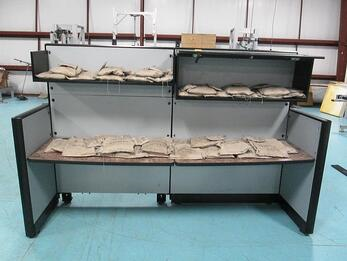Panel Systems that Make Sense
When customers purchase console furniture, it often includes a discussion about panel systems. If you speak with a variety of vendors, you will certainly get a variety of panel solutions as well. I’ll share with you what is needed from panel systems (or “core systems”) so that you end up with the most efficient option.
Does Panel Size Matter?
Some manufacturers propose that the wider the core is, the more advantageous it will be, as you will be able to fit more cabling or computers within the core. That may be true. The benefit hinges on how you’re running power and data to your workstation and what access you need to those data lines or the computers.
Clearly, you can stuff more cables inside of a 6-inch panel than a 3-inch panel system. The truth is that you do not want to run any cabling through a panel system if you have a raised floor, as it is incredibly complicated to maintain and replace cables when wound through these systems. Ask your IT person: If they had to pull the old Cat4 cabling for an upgrade, would they prefer to do it through raised flooring or wound through multiple panel systems. If you do not have a raised floor and cannot run power and data from the ceiling through power poles, you may need to route through panel systems. When it really comes down to it, it’s not the larger size of the panel that matters. In fact, isn’t the real estate in your center better used for your employees than to place dormant cabling? I think so. A smaller panel system gives more workspace to your employee and puts the cabling where it belongs.
How Strong Does Your Workstation Panel System need to be?
Think back a moment. Remember when monitors weighed 45 pounds or more? When equipment weighed more, vendors would boast about their panel systems’ stacking abilities and load capabilities. Why? Because they were creating cubicles that stacked and needed to hold heavy equipment. Today, panel systems are often rated at over 700 (Xybix's steel system is rated at 1,200 pounds, see test photo below), but this is not nearly as critical today as it was in the past when equipment was heavier.

You may hear vendors talk about their 14-gauge cold rolled steel frames. All vendors have this or something similar. But the need for 1,200 pounds is rare today with the technology it is supporting. The strength of the steel is moot for the system, unless you’re discussing a steel product like a drawer that gets bent easily by the user.
Does Venting Matter When Selecting Panel Systems for Your Consoles?
The final consideration when it comes to panel solutions is selecting the best housing for your computer equipment. Many vendors place the computers inside the panel system itself. The benefit here is the easy access (if it’s not under the work surface of course). Typical steel enclosures have vented tops to allow hot computer air to rise, and vented sides to allow cool are in. Without fans, those are called “passive cooling” systems. These are used in RFPs and bids as they are less expensive. But are they best for your computer system?
Remember that inside each computer is a fan designed to actively vent the heat out of the unit. HP, Dell and other computer companies realize the important of this “active cooling” system over a passive system. Many panel systems refuse to include active, redundant, fan-cooled solutions as they rely on the cooling system of the computer manufacturer to manage this. Opened panel system doors and removed panel tiles in communication centers reveal that it is not cool enough. Passive cooling created by stuffing CPUs in metal casings is hardly redundant, so be sure to look for reliable cooling options to best protect your investment. A computer enclosure with active cooling fans plugged into UPS power are a good solution.
Finally, when the inevitable occurs and the Big Gulp sitting on that vented panel system wall falls over, Dr Pepper will drench the equipment in that panel wall. Because these types of accidents occur from time to time, it’s very important to think through all the risks when selecting panel solutions.
There are a variety of great panel solutions to choose from and you can find the best option by simply doing your due diligence when you evaluate the type of solution needed in your unique center. Ready to talk in more detail?



